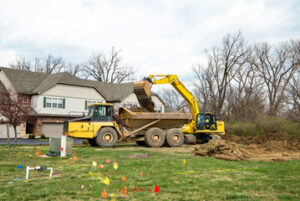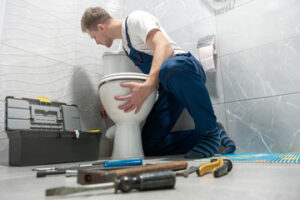Professional chimney sweeps use brushes and rods to dislodge soot and creosote from the walls of the chimney. They also use a drop cloth or tarp, safety gear, a shop vacuum with dual HEPA filters, and an ash bucket.

Creosote is a sticky, black substance that forms during wood burning and accumulates in the chimney or fireplace. It’s flammable, poisonous in high doses and can lead to serious health problems. Creosote is also corrosive and can damage the flue, chimney liner and connector pipe. It’s difficult to remove and can clog the chimney. The NFPA recommends annual chimney inspections to determine whether creosote accumulation has reached hazardous levels. Chimney sweeps have the tools and know-how to safely remove this dangerous byproduct. Contact Chimney Cleaning Charleston SC for professional help.
Creosote builds up in three stages. The first stage is thin and flaky, resembling soot that can be removed easily with a basic chimney brush. The second stage looks more like tar and may be harder to remove. This is where the danger begins as this layer can easily ignite when exposed to high heat. A chimney fire can then spread to the attic, roof deck and ceiling of your home.
Chimney sweeps can prevent this by recommending and applying a creosote-removal product before sweeping. These products are a liquid spray or powder that can be applied to the fireplace or directly on the fire. They chemically break down the glazed creosote into ash, making it easy to remove with a basic chimney brush. The ACS creosote removal products can even be used to pre-treat wood before burning.
If a chimney is not regularly swept, the creosote will continue to build up and move into the second stage. When a chimney is not inspected or cleaned, the second stage creosote will form in shiny black flakes that look more like tar than soot. This layer is more brittle than the first and may require specialized brushes or scrapers to remove. It is also flammable, but not as combustible as the first stage.
If the creosote layer reaches the third stage, it will look more like a thick tar coating or running down the chimney. This is extremely flammable and can cause chimney fires and serious property damage. It can also vaporize and be carried into the house, where it can ignite combustibles in rooms or on the attic floor. If this happens, it is important to call a professional immediately.
Debris
Keeping a chimney clean reduces dust and debris that can obstruct a fire and cause dangerous blockages. As a result, it improves airflow so that smoke and gases are able to escape properly. This can prevent carbon monoxide buildup in the home, which is an invisible and odorless gas that can be deadly if inhaled in large quantities.
Chimneys are lined with a material known as pargeting, which is typically made from lime mortar in older houses or a sand and cement mix in newer homes. Occasionally, bits of the pargeting can get dislodged from the liner and fall down the chimney. This can be dangerous for pets and small children who may play near the fireplace or try to reach the flames. It also prevents proper chimney function and can lead to chimney fires or other structural problems.
Professional sweeps use specialized equipment to remove creosote and other debris from the walls of the chimney flue, as well as to identify and repair any cracks or structural issues. The process is a messy one, and it’s important for homeowners to protect the surrounding area by covering floors and furniture with tarps or drop cloths. It’s also a good idea to wear eye protection and a dust mask when handling a chimney brush, which can contain sharp tempered spring-like wire that may scratch surfaces or injure a person.
When a chimney is dirty, it can also prevent a fire from burning completely, which results in unburned wood and soot accumulating in the flue. This unburned material can spark and ignite a chimney fire that is difficult to control. The resulting smokiness can spread throughout the house and even onto the roof. Chimneys that have been swept regularly are much less likely to suffer from fire damage.
The flammable tar-like residue called creosote is the leading cause of chimney fires. It is dangerous for pets and children, but cleaning your chimney regularly can reduce its risk and ensure that it works correctly. Chemical cleaners can dissolve some of the creosote, but they are not a substitute for thorough chimney sweeping and inspections.
Safety
A chimney is an important part of a home, providing warmth and ambiance while also protecting the home from dangerous carbon monoxide leaks. However, over time, it can become obstructed with soot, creosote and other debris that can make it unsafe to use. Regular chimney sweepings remove these blockages and ensure that smoke, toxins and other byproducts of combustion are properly vented outside. Chimney cleaning is a must for any homeowner who uses a fireplace or wood stove.
Safety is a major reason for scheduling regular chimney sweepings, as flammable byproducts like creosote and soot can ignite if they build up to excessive levels. Chimney fires are a serious concern and can cause substantial damage to the chimney, as well as the surrounding structure of the home. A professional chimney sweep will thoroughly clean the chimney, significantly lowering the risk of fire.
Creosote accumulation also reduces the efficiency of a chimney, as it builds up on the inner walls of the flue. This impedes the flow of smoke and other byproducts of combustion, making it difficult to tell whether or not there is a fire burning in the fireplace. Professional chimney sweepings will remove the creosote and restore the flue’s efficiency, ensuring that smoke, gases and byproducts are properly vented outside.
While it is possible to clean a chimney on your own, it is important that you use the proper equipment and follow proper safety procedures. When cleaning your own chimney, you should have the following supplies:
Chimney Brushes and Extension Rods
Using the right brushes will ensure that all areas of the chimney are cleaned thoroughly. Be sure to purchase brushes that are designed for your specific type of chimney and flue liner. You will also need a ladder, if needed. Ensure that the ladder is in good condition and that it is positioned properly to prevent any accidents. You should also wear the proper safety gear, including protective goggles and work gloves. You should also have a drop cloth or tarp, a shop vacuum, a flashlight or headlamp, an ash bucket and a dust mask.
Environment
In addition to reducing fire hazards, chimney cleaning improves your home’s indoor air quality. As a byproduct of wood-burning fires, chimneys typically accumulate soot and creosote. These substances can degrade indoor air quality, causing respiratory problems in family members. Regular chimney cleaning prevents these issues by ensuring that smoke and other harmful gases are properly vented outside.
One of the most common signs that your chimney needs cleaning is a visible accumulation of creosote on the interior surfaces. This substance is a natural byproduct of burning wood and can vary in appearance from powdery residues to tar-like deposits. When left untreated, this material can degrade the chimney’s walls and create openings that allow dangerous gases like carbon monoxide to enter the house.
A clean chimney also protects the surrounding environment. When a chimney is dirty, it can become an ideal breeding ground for mildew and mold. These spores are easily dispersed throughout the home and can cause respiratory problems, especially in children and elderly people. Regular chimney sweeping and maintenance prevents these issues by keeping moisture levels low in the chimney.
Chimney sweeps use a variety of tools to clean and inspect chimneys. They may start from the bottom or top, depending on accessibility, and they generally set up drop cloths or plastic to avoid contaminating floors and walls with debris and chemicals. They also use a powerful vacuum to remove dust and other debris, leaving the chimney clean and free of obstructions.
Besides the dangers of chimney fires, dirty chimneys can also lead to a variety of other problems. They can obstruct the flow of exhaust gases, preventing them from being safely vented outside. This can be particularly hazardous if the chimney is blocked by soot, animal nests, or other debris. It can also cause carbon monoxide to back up into the home, which is a colourless, odourless, and deadly gas.
Some traditional chimney cleaning products contain toxic chemicals such as ammonium chloride, which can cause respiratory irritation and eye damage. Luckily, eco-friendly cleaners are becoming increasingly popular, as they are safer for homeowners and the surrounding environment. These cleaners are made from natural ingredients and do not contain harsh acids that can contaminate soil and waterways, harming wildlife.








